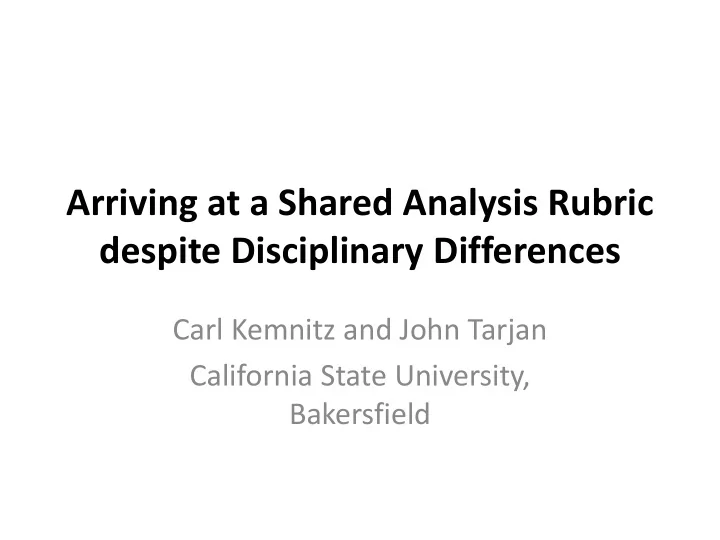

Arriving at a Shared Analysis Rubric despite Disciplinary Differences Carl Kemnitz and John Tarjan California State University, Bakersfield
Context • Compass proposal to explore Critical Thinking Across the Curriculum • CSU, Bakersfield + Bakersfield College + Taft College • Business Administration, Chemistry/Biochemistry, Economics, English, Geology, History, Library, Management, Mathematics, Music, Philosophy, Psychology, Public Policy and Administration, Religious Studies, Social Science, Sociology, Spanish
First Step: Agreement on a Definition of Critical Thinking and a Rubric AAC&U VALUE Rubric • Definition: “Critical thinking is a habit of mind characterized by the comprehensive exploration of issues, ideas, artifacts, and events before accepting or formulating an opinion or conclusion.” Not Controversial. • Rubric: Quickly rejected!
Learning Outcome Selection • Dispositions • Skills – Analysis: breaking an existing argument into its parts (i.e., premises and conclusions) – Evaluation: is the argument reasonable, fully supporting the conclusion? – Reaching Conclusions: including creative problem solving
Democratically Selected
Rubric Development • Learning Outcome: Students should be able to analyze arguments, breaking them down into their constituent parts. • Terminology: Disciplinary Differences – “argument” = critical thinking artifact – “premise” ≈ “evidence” ≈ “reason”
Our Analysis Rubric Skill Level: 1 2 3 4 Identification of Identifies the Identifies the conclusion Cannot identify Completely and the main conclusion incompletely with very minor the main accurately identifies conclusion or with notable inaccuracies (or conclusion. the main conclusion. inaccuracy. incompleteness). Identification of Identifies many Successfully identifies a Completely and Many premises premises* premises with notable vast majority of all correctly identifies all are improperly supporting the exceptions or frequent premises with only minor premises without any identified. main conclusion misidentifications. misidentifications. misidentifications. *Premises. Any or all of the words “evidence,” “premise,” and “reason” may be used if they are functionally equivalent within the discipline. Note: Assignments will vary greatly in their difficulty. Student development is measured by improved skill level and/or by continued success with more difficult assignments. Optional “Beta Testing” Extended Rubric developed to evaluate subarguments and remaining claims.
Calibrating the Rubric Identify the Main Conclusion Philosophers: Any contamination of the conclusion with information from premises indicates that the student cannot distinguish. Others: …but they seem to understand what the author’s main point.
Preliminary Assessment Results • Pre-test/post-test for 161 students • 7 Courses • Students at all performance levels (cumulative GPA) showed some improvement in identification of premises • Performance in Area A3, Critical Thinking course was less predictive • Freshmen and Sophomores showed greatest improvement. • Pre-test scores were correlated with class level, however, post-test scores were not.
Lessons Learned • Disciplinary differences – Terminology – Skill sets – Interpretation of rubrics • Good will is essential: abide by consensus decision • Extensive interaction is essential – Time consuming – …but FUN! • Tangible examples greatly increased the efficiency of our discussions • Task-oriented leadership is essential
Next Challenges • How do we ensure that Area A3 courses are responsive to the needs of students taking other coursework? • How can we reinforce foundational critical thinking skills developed in Area A3 courses? – Assignments – Rubrics
Recommend
More recommend